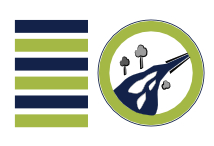The tool was developed in the OSCAR project (project website), is synthesizing and complementing the knowledge on the effects of woody riparian buffers, and providing online learning tools for the four most important functions
- Nutrient and fine sediment retention
- Water temperature
- Biodiversity
- Ecosystem services

Woody riparian buffers along rivers impact multiple ecosystem functions through shading and reducing water temperature, retaining nutrients from agricultural areas, providing leaves and wood as food and habitat for aquatic insects and fish, which in turn enhances biodiversity but also increases the recreational value of the river landscape (read more).
Processes supporting these functions and services usually have a spatial connotation and are related to the local woody riparian buffers. However, the processes operate at different lateral scales (e.g. shading mainly depends on trees directly bordering the river while cultural ecosystem services like recreation are provided in the wider context of the valley). Moreover, these local conditions impact downstream sections (e.g. leaves entering locally being washed downstream) and can also connect upstream regions in habitat and migration contexts. Hence the functions operate at different spatial scales, and accordingly study areas of different width (buffers of fixed width, the whole riparian area and valley floor) and upstream conditions have to be considered.

For each of these four main functions of woody riparian buffers, the relevant spatial scales were identified, knowledge rules developed for the main causal relationships and shown in a conceptual model, which was translated to an interactive Bayesian Belief Network for nutrient retention [link to shiny application] and water temperature [link to shiny application].
The conceptual models were applied in case-study catchments and results for the present conditions and three future scenarios are presented for each of the four effects.
The results on each of the four functions is summarized and online learning tools available in the four boxes below. In addition, OSCAR results in a nutshell are available.
This research has been funded through the 2015-2016 BiodivERsA COFUND call for research proposals, with the national funders German Federal Ministry of Education and Research (01LC1618A), Agence National de la Recherche (ANR-16-EBI3-0015-01) and Research Council of Norway (268704/E50). OSCAR project website




